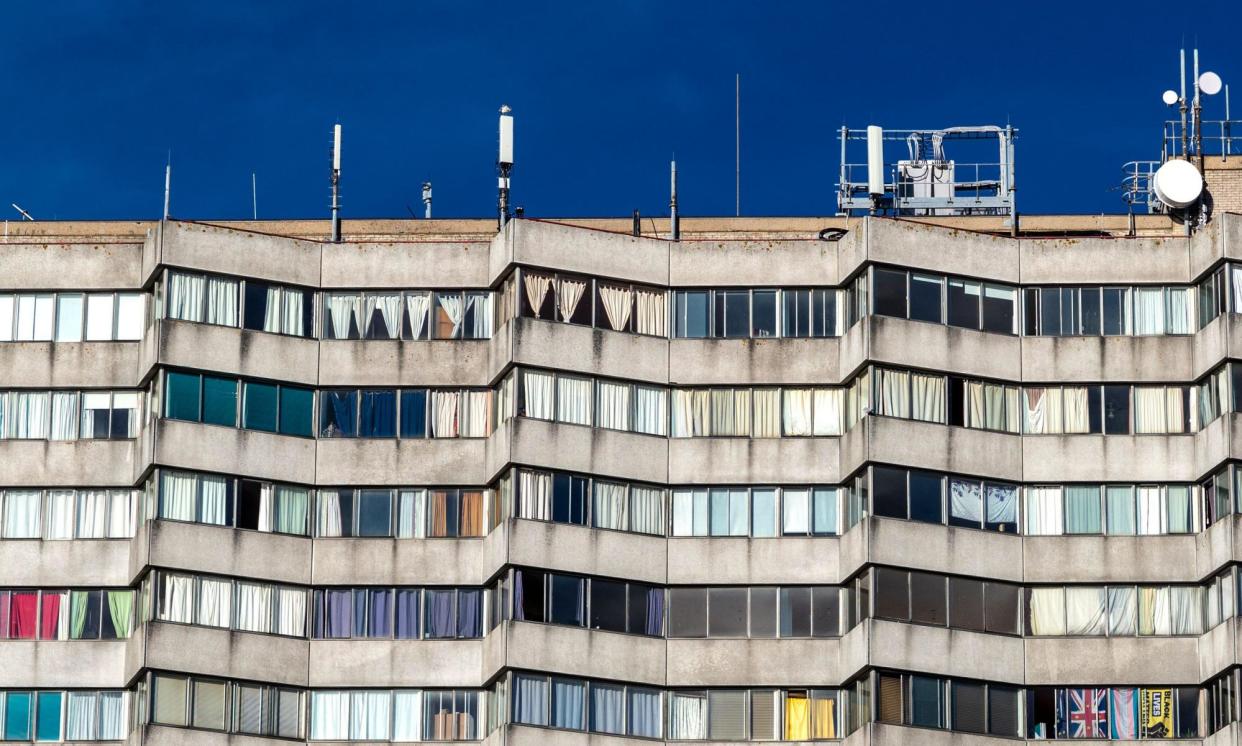Tracey Emin among hundreds opposing changes to Margate ‘brutalist masterpiece’

The 18-storey Arlington House in Margate has long been considered a brutalist masterpiece. It inspired the English rock band Hawkwind’s song High Rise and recently featured in Sam Mendes’s Bafta-nominated film Empire of Light.
But now, the building, which sits on Margate seafront next to the railway station and the amusement park Dreamland, has become the cause of a bitter dispute among local people.
One of the UK’s most prominent artists, Tracey Emin, is among hundreds of people protesting against the building management’s proposed changes to the tower’s original windows, which have been in place since its opening in December 1963.
Emin, who owns one of the flats, the architectural preservation charity the Twentieth Century Society and 200 others have lodged objections with Thanet district council. They say changes will destroy the architectural character of the block, reduce views of the coast from inside and irrevocably ruin the authenticity of the building.
“Arlington House is a historic building in Margate, at the time of its construction Margate was booming and it was an emblem of the future,” Emin said. “In the last few decades it’s been left to go to rack and ruin without care or respect for its monumental brutalist architecture. If this building were in any European town or city it would have been protected from the beginning. It should be listed and renovated back to its original beauty.”
Emin, who was nominated for the Turner prize, opened Tracey Emin Studios in Margate last year and said Arlington House’s leaseholders, Freshwater Group of Companies, “understood this responsibility” when taking on the building and should not get away with “replacing the original windows with bulky, unsuitable and inappropriate windows”.
She added: “As a flat owner in Arlington House I’m totally opposed to their proposal. In short these are the wrong windows for this building.”
Freshwater says the replacement window scheme should have a positive impact on people who live in the building and the area as a whole. The company says the window replacements are part of a wider repair and refurbishment scheme that when completed will help restore the prominent building.
In planning documents, Freshwater has said the difference between the existing and new windows is “minimal” and will not alter the heritage and legacy of the building.
But people who live in the block say the plans will ruin the aesthetic of the 142-flat building and its view. One person said planners wanted to remove the original sliding windows and replace them with “tilt and turn” ones with thicker frames. This would involve the window frame being made five times thicker.
It is also understood that the lease structure, and therefore the window ownership, in the building means that not all the windows will be changed, which will lead to a patchwork of window types.
Those protesting say no elevations of the proposal have been submitted for planning so it is impossible to understand what the building will look like, or which windows will be changed.
But not everyone is opposed. Previous reports have indicated that a number of people are keen for cost-efficient double glazing, and blame “London hipsters” for flocking to Margate and the tower and preventing essential modernisation.
Lyndon Brand, 60, told KentOnline the windows are “just terrible. They rattle and shake. Many have had seagull strikes and cracked. In the summer, the heat distorts the frames and cracks the glass. The slightly thicker frames are a small price to pay. You wouldn’t notice it.”
Another person in the block said her heating bill was “astronomically” expensive.
Arlington House was designed by the architect Russell Diplock, who also designed the Brighton Centre and nearby Churchill Square, and was initially advertised as “Britain’s first ‘park and buy’ shopping centre with luxury flats”.
The sides of the building have a wave-like design, which provides every flat with inland and sea views. Today, the commercial section is vacant after a proposal to redevelop it into a Tesco store was unsuccessful.
Thanet district council said: “While we do not comment on individual planning applications, each one is considered on its own merits and takes into account feedback from the public and relevant bodies.
“All comments received in relation to this application can be viewed on our planning portal. The planning committee will be provided with a summary of the comments received so that they can be fully considered when the application is determined.”
Highdorn, a part of Freshwater Group, has been approached for comment.
• This article was amended on 17 September 2024. An earlier version said that Tracey Emin had won the Turner Prize; in fact she was nominated but did not win.


